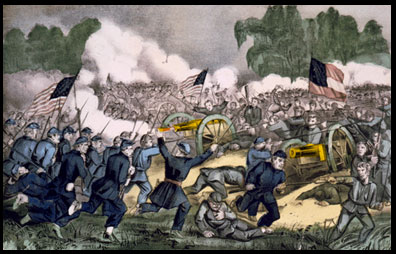

By the summer of 1863, Lee had taken his army back into the North. His troops' morale had never been higher after his finest hour as a general, winning the Battle of Chancellorsville in May by daringly splitting his army in two. Lincoln kept burning through commanding generals desperately trying to find someone who could effectively take the fight to Lee.
By chance, the two armies met in the small town of Gettysburg. Ironically, Lee's army entered from the North, and the Union from the South, coming up from Washington, D.C. It took a full day for the latest Union commander, General George Meade to arrive on the battlefield with the bulk of the Army of the Potomac. Yet, after those three days at Gettysburg, July 1-3, 1863, Meade delivered a crippling blow to the Army of Northern Virginia that Lee never fully recovered from.
The battle of Gettysburg is a classic military study on the importance of terrain. Through the entire battle, the North held the superior ground and commanders had to make fateful decisions. Each of the three days also has a famous "what if" scenario that could have changed the course of the battle and therefore, the war.
As you click on each day below, you will be asked to consider the importance of geography. Click each tab to learn more about the day.
Almost immediately afterwards, Gettysburg became one of the most famous battles in military history. There were 50,000 casualties over the three days. Almost as many Americans lost their lives at Gettysburg than in the entire Vietnam War. Lee had lost a huge portion of his best soldiers and valuable equipment that were irreplaceable. He never would try to attack the North again. The North was overjoyed, especially with the news that on July 4th Ulysses S. Grant had captured Vicksburg and seized control of the Mississippi River.
In November of 1863, the Union would commemorate its great victory with a ceremony dedicating the national cemetery on what had become sacred ground for the United States. The highlight of the ceremony was a two hour speech by a famous orator, followed by a two-minute speech by President Lincoln, which would eventually become treasured as the best statement of democratic principles ever written.
Sources of images used for this section as they appear, top to bottom: